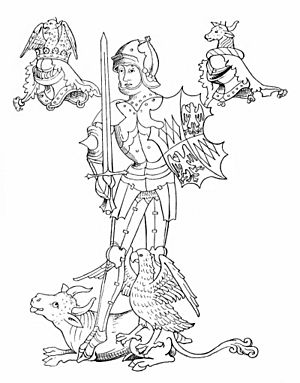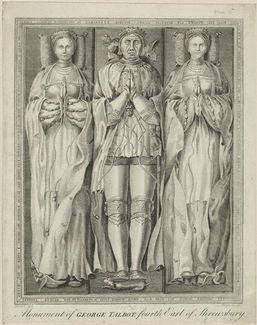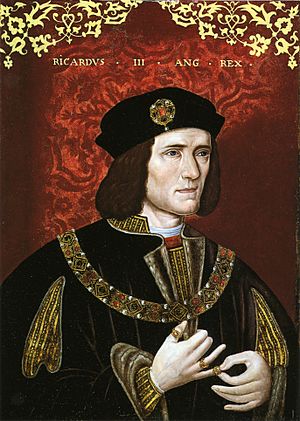Katherine Neville, Baroness Hastings facts for kids
Quick facts for kids
Katherine Neville
|
|
|---|---|
| Baroness Harington of Aldingham Baroness Hastings |
|
| Born | 1442 England |
| Died | between 22 November 1503/25 March 1504 England |
| Buried | Ashby de la Zouche, Leicestershire |
| Noble family | House of Neville |
| Spouse(s) | William Bonville, 6th Baron Harington of Aldingham William Hastings, 1st Baron Hastings |
| Issue | Cecily Bonville Richard Hastings William Hastings Sir Edward Hastings, 2nd Baron Hastings Richard Hastings William Hastings Anne Hastings |
| Father | Richard Neville, 5th Earl of Salisbury |
| Mother | Alice Montacute, 5th Countess of Salisbury |
Katherine Neville, Baroness Hastings (born 1442 – died 1504), was an important noblewoman in England. She belonged to the very powerful Neville family from the north of England.
Katherine was one of six daughters of Richard Neville, 5th Earl of Salisbury. Her brother was the famous military leader Richard Neville, 16th Earl of Warwick. He was known as Warwick the Kingmaker because he helped decide who would be king.
Katherine was married two times. Her first husband was William Bonville, 6th Baron Harington. They had a daughter named Cecily Bonville. Cecily became the richest heiress in England. This happened after Katherine's husband and father-in-law died in the Battle of Wakefield. A short time later, her husband's grandfather was also executed.
Katherine's second husband was William Hastings, 1st Baron Hastings. He was a powerful noble. King Richard III ordered his death in 1483. After this, King Richard III promised to protect Katherine herself.
Contents
Katherine's Family

Lady Katherine Neville was born in 1442. She was one of ten children. Her parents were Richard Neville, 5th Earl of Salisbury, and Alice Montacute. Alice was also the 5th Countess of Salisbury in her own right.
Katherine's older brother was Richard Neville, 16th Earl of Warwick. He was called "Warwick the Kingmaker." He was one of the most important people in England. He played a big part in the Wars of the Roses. These were civil wars fought between two families, the House of York and the House of Lancaster, for control of the English throne.
Katherine's aunt was Cecily Neville, Duchess of York. Cecily was the mother of future kings, Edward IV and Richard III. These kings were Katherine's first cousins. Her niece, Anne Neville, later became Queen of England. She married Richard III.
Marriages and Children

Lady Katherine married her first husband, William Bonville, in 1458. The Bonville family, like Katherine's family, supported the House of York. Katherine and William had one daughter:
- Cecily Bonville (born around 1460 – died 1529). She became the 2nd Baroness Bonville and 7th Baroness Harington. She married Thomas Grey, 1st Marquess of Dorset and had many children.
Katherine's husband, William, and his father were killed in the Battle of Wakefield on December 30, 1460. This battle was a defeat for the Yorkists. The Lancastrian forces, led by Queen Margaret of Anjou, won. Katherine's father and a cousin were also killed after this battle.
Less than two months later, William's grandfather was executed. This happened after another Yorkist defeat at the Second Battle of St Albans. Queen Margaret of Anjou ordered his death.
Katherine was only eighteen years old when she became a widow. But she did not stay a widow for long. In 1462, her brother, the Earl of Warwick, arranged a new marriage for her. She married William Hastings, 1st Baron Hastings. He was a powerful noble and a close friend of King Edward IV. Edward IV had become king in 1461.
Katherine brought her daughter Cecily's inheritance to her new husband. William Hastings and Katherine had six children together:
- Richard Hastings (1464–1465)
- William Hastings (1466–1466)
- Sir Edward Hastings, 2nd Baron Hastings (1466 – 1506). He married Mary Hungerford and had children.
- Richard Hastings (born 1468)
- William Hastings (1470 – after 1540). He married Jane Sheffield.
- Anne Hastings (around 1471 – 1520). She married George Talbot, 4th Earl of Shrewsbury and had many children.
The Death of William Hastings

King Edward IV died in 1483. His young son, Edward V, became king. But he was too young to rule. So, Edward IV's youngest brother, Richard, Duke of Gloucester, became the Lord Protector. This meant he would rule the country until the young king was old enough.
Katherine's husband, William Hastings, advised Richard to take the young King Edward V into his care.
William Hastings became worried that he was losing his power under Richard's rule. He then joined a plan against the Lord Protector. When Richard found out about Hastings' plan, he ordered his immediate death. This happened on June 13, 1483, at the Tower of London.
Richard then told Katherine that Hastings' property would not be taken away. He promised to protect her rights and property.
Soon after Hastings' death, Richard was declared King of England. This was supported by a special law that said his nephew, King Edward V, and his siblings were not rightful heirs. Richard was crowned king in July.
Even though Richard had promised to protect Katherine, his friend Francis Lovell, 1st Viscount Lovell claimed some of Katherine's properties. These properties had been left to Katherine after her husband's death. To keep them, Katherine had to pay Lovell money and give him other lands. King Richard did not stop his friend from doing this.
King Richard was killed at the Battle of Bosworth in 1485. Henry Tudor then became King Henry VII. Katherine's oldest living son, Edward, fought for King Henry against Lovell in another battle in 1487. This battle was the final defeat for the House of York.
Later Life and Death
Katherine never married again after William Hastings died. She passed away in early 1504. She had made a will on November 22, 1503. In her will, she asked to be buried in the church at Ashby de la Zouche, Leicestershire. Her will also named her oldest daughter, Cecily, as one of the people to carry out her wishes.
Her will was officially approved on March 25, 1504. This means she died sometime before that date.

